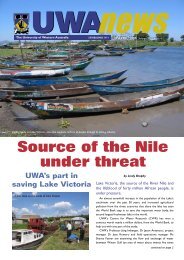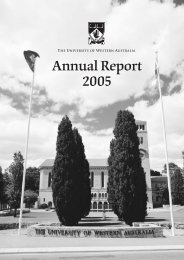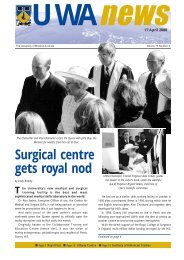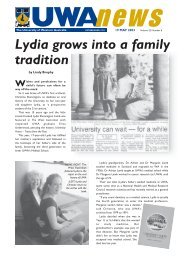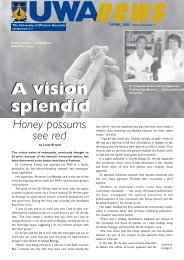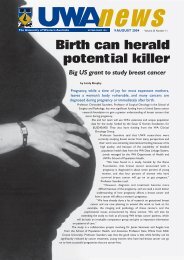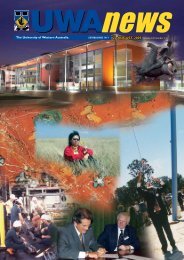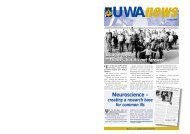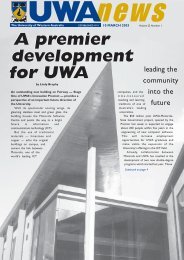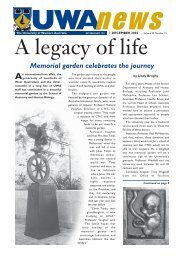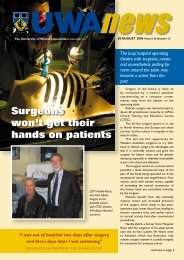July 24, 2000 - Publications Unit - The University of Western Australia
July 24, 2000 - Publications Unit - The University of Western Australia
July 24, 2000 - Publications Unit - The University of Western Australia
Create successful ePaper yourself
Turn your PDF publications into a flip-book with our unique Google optimized e-Paper software.
4 UWA newsNew course provesits caseContinued from page 1up their time to hear the mootcases and cross-examine thestudents.Judges Shauna Deane and PaulHealy each gave a day to sit on thecases.Pr<strong>of</strong>essor Bailey said the ninegraduates were already in work. Twowere serving members <strong>of</strong> the WAPolice Force (working in the forensicarea but wanting pr<strong>of</strong>essional training),and another is in training at the PoliceAcademy. Others have work with thePathCentre and the Federal Police.“We want more lawyers and policeto do the course. It’s especiallyimportant to lay juries that forensicexperts can show their qualifications.Cases like Lindy Chamberlain’s swungon the ‘pieces <strong>of</strong> paper’ produced byforensic experts who were brought inby the defence from overseas. <strong>The</strong>prosecution didn’t have those ‘pieces<strong>of</strong> paper’ to prove their expertise and“It’s especially important tolay juries that forensicexperts can show theirqualifications . . . theprosecution (in the LindyChamberlain case) didn’thave those ‘pieces <strong>of</strong> paper’to prove their expertise andthat case failed the<strong>Australia</strong>n public . . .”ABOVE: Executive Dean, Pr<strong>of</strong>essor GeorgeStewart and Pr<strong>of</strong>essor Win Bailey at thecourthouse.LEFT: Dr Ian Dadour, supervising thecase studies with Pr<strong>of</strong>essor Win Bailey.that case failed the <strong>Australia</strong>n public,”Dr Dadour said.About 30 UWA staff, from five out<strong>of</strong> the six faculties, contribute to theGraduate Diploma in Forensic Science.<strong>The</strong> unit also links with the <strong>University</strong>’sCrime Research Centre and usesexpertise from the PathCentre, CSIRO,the Chemistry Centre and AgricultureWA.As well as the graduate diploma(equivalent to one year <strong>of</strong> full-timestudy), the unit also <strong>of</strong>fers a master’sdegree in forensic science (two years<strong>of</strong> full-time study).Clearing the way for war victims’ future Continued from page 3<strong>The</strong>re are currently no availablemeasurements on mine detection dogperformance, although dogs have beenused, with some degree <strong>of</strong> success.Recent failures by dogs in BosniaHerzegovina have caused great concern.Associate Pr<strong>of</strong>essor Trevelyan’swork in Lebanon has helped to drawinternational attention to the mineproblems there, where casualty ratesexceed levels in Bosnia and Croatia.“<strong>The</strong> recent withdrawal <strong>of</strong> Israeliforces will enable Lebanon to startclearance operations in the south <strong>of</strong> thecountry.“However, they will need assistancefor this work. Israeli authorities haveundertaken to provide locations <strong>of</strong> theminefields their forces laid, butexperience in Jordan shows that evenprecisely located minefields pose hugeproblems for deminers,” he said.An Afghan deminer uses his dog to sniff out buried mines.RIGHT: Project <strong>of</strong>ficerSabbia Tilli with theprotective suit,designed to protectAfghan deminers whoprefer to squat as theywork in the field.THE UNIVERSITY OF WESTERN AUSTRALIA • JULY <strong>24</strong> <strong>2000</strong>



